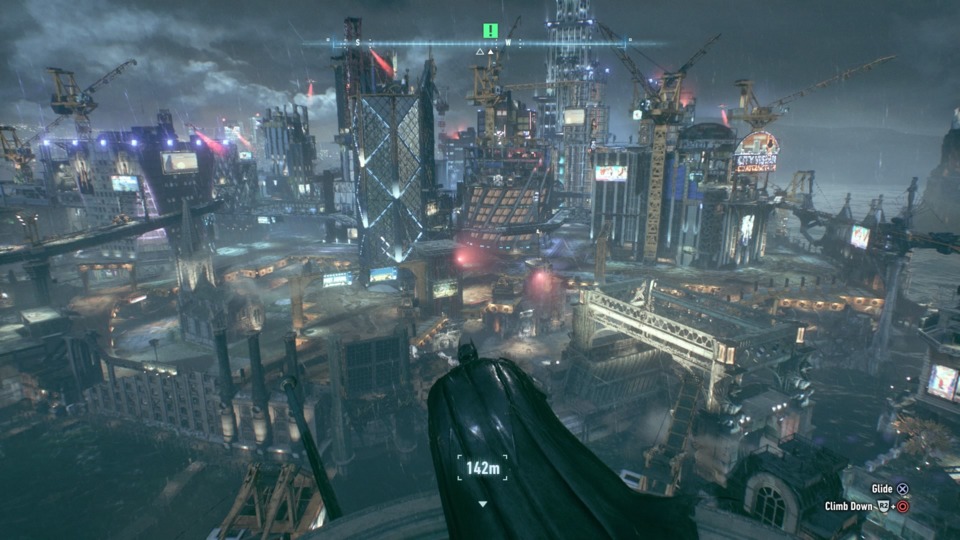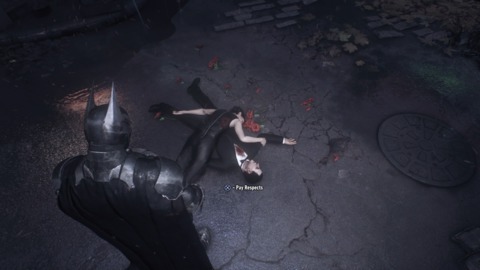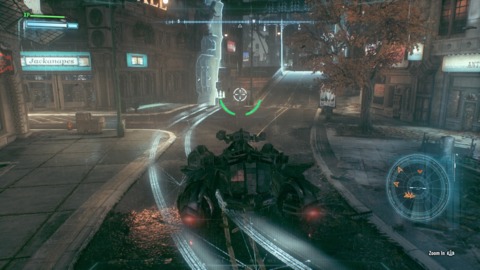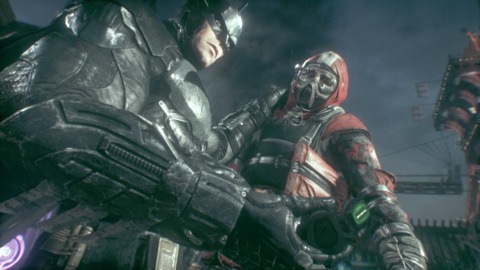How Batman: Arkham Knight’s Scope Dampens a Great Story
By Darth_Navster 6 Comments
Rocksteady’s Batman series has been an almost perfect representation of modern AAA development. The first game, Batman: Arkham Asylum, was a big budget gamble with innovative mechanics that achieved enormous marketplace success. The second game, Batman: Arkham City, expanded the scope with an open world and achieved even greater success. We then got the “off-year” spin off game, Batman: Arkham Origins, made by a different developer and felt like a phoned-in effort. And finally, Rocksteady returns to complete their “Arkham trilogy” with Batman: Arkham Knight. With the jump in console horsepower this time around I can imagine pressure was high to deliver a bigger and better sequel to send off the Dark Knight. Unfortunately, it is this drive for bigger and better that ultimately sinks Arkham Knight.

Before I dig into the latest game, I’d like to explain what appeals to me about the series. I still hold Arkham Asylum as the franchise’s best simply for its focus.The game takes place in the relatively constrained confines of Arkham Asylum, the madhouse where Batman deposits his super-villain quarry. Whether this was simply due to the limited resources that Rocksteady had at the time or otherwise, this decision allows for the narrative to take center stage. The opening sequence as Batman escorts the Joker to be locked up in the bowels of the Asylum is memorable because it gives the player a preview of what was to come, with glimpses of villains like Killer Croc. It evokes the original Half-Life’s introduction but uses the homage effectively to convey where we are in the story. Batman is established by his rapport with Commissioner Gordon and he has already tangled with the inmates of the facility. The Joker in particular is presented effectively, with no one feeling particularly at ease even with the villain completely strapped down and our hero nearby. When things go inevitably sideways and the inmates gain control of the facility it feels earned and gives the player plenty of motivation to get the house back in order. The rest of the game more or less maintains this quality of writing and scripting to make each major antagonist feel distinct yet thematically linked. While not perfect, especially with respect to the overly sexualized female villains and uninspired ending, Arkham Asylum managed to nail what it felt like to both be Batman and inhabit his universe. The gameplay also held up with an oft imitated fighting system as well as stealth that made the player feel like a true predator in the night. Rocksteady even managed to integrate Batman’s gadgets into the mix by building the world into one of the best 3D metroidvanias ever made.

Arkham Knight ostensibly has many of the trappings that made the first game so great. The fighting system is as sharp as ever, the stealth sequences are well paced, and the story is top notch. I was surprised by the quality of the narrative, especially after the events of Arkham City leaving the Joker dead. In my opinion there has always been a wide gulf in appeal between the clown and the rest of Batman’s rogues gallery. I fully expected to be let down by Scarecrow and the newly introduced Arkham Knight, but Rocksteady made an inspired choice bringing back the Joker as an ongoing hallucination in the Caped Crusader’s mind. At first this feels like pandering akin to Arkham Origins’ late reveal of the Joker, but here it feels more nuanced. The Joker now feels like less a threat and more akin to a Greek chorus, echoing both my thoughts as well as exposing the doubts and fears behind the stoic cowl. Indeed, the Joker acts as a conduit for one of the more intimate looks into what drives Bruce Wayne to do what he does. The threat Scarecrow poses is almost secondary to the internal struggle our hero faces, and the focus on the “Bat Family” of Robin and Oracle (among others) makes it all the more personal. It really is compelling stuff that drove me to see it through to the end. Unfortunately, that was about the only thing keeping me going.

I’m not yet of the opinion that open worlds in general are bad for games, but I do feel that the shoehorning of open worlds into certain games is harming AAA development. Batman: Arkham Asylum is no exception to this trend and feels unfocused as a result. There is plenty of stuff to do in the game and characters will often nudge you off the main story to pursue secondary criminals that are terrorizing Gotham. But most of these criminals have already been seen in Asylum, City, and Origins and capturing them yet again feels pointless. I was particularly put off by the latest set of Riddler challenges, which are less mind teasers and more obstacle courses for the newly introduced Batmobile. Oh yes, the Batmobile, the most visible aspect of Arkham Knight’s bigger and better philosophy. The burly vehicle has been incorporated into most aspects of the game but rarely impresses. The game is chock full of interminable sequences where the Batmobile must go into the lame “tank-mode” and have pointless shooter battles with enemy tanks. These sequences all tend to go on far too long and feel completely out of sync with the version of Batman seen in the Arkham series. Sure, the game tells you that the tanks you’re blowing up are unmanned, but it just feels like a weird logical contortion to justify Batman’s new militarized toy. I’m usually ok with stretching the narrative to accommodate gameplay but that gameplay has to be good. The Batmobile does not improve a single aspect to how the Arkham series plays. Traversal is still better with the grappling gun and I’d much rather punch enemies than shoot them.

The one thing I will have to thank Arkham Knight for is finally breaking me of my completionist streak in open world games. After trying a few side missions and disliking them I simply mainlined the story. For the most part this helped me enjoy the game’s story a fair bit more as I was able to proceed with an urgency that the narrative demanded. There were a few gameplay sequences that felt like I was “underleveled”, particularly those previously mentioned tank battles, but a bump down to Easy difficulty took care of that. Annoyingly, the game’s “true” ending would only trigger on 100% completion, but a quick search on YouTube allowed me to enjoy the coda without any additional slogging.
Batman: Arkham Knight is not a bad game, merely an overstuffed one. There are great ideas at work here that is overshadowed by our ever greater demands for more content. Rocksteady has indicated that this will be their last Batman game and I hope that whatever they do next allows them to hit the reset button on constantly raising the stakes. It’s clear that they have a talented team that is exceptionally good at presenting a story within an interactive medium, and it would be a shame to see that work overshadowed yet again by another large scale project. The enjoyment one will get out of Arkham Knight is inversely proportional to how tired one is of the series. If you’re crazy like me and played through Origins, consider this safe to skip. The cowl’s been hung up, and like an aging Bruce Wayne, it does so while not quite getting the point of it all.